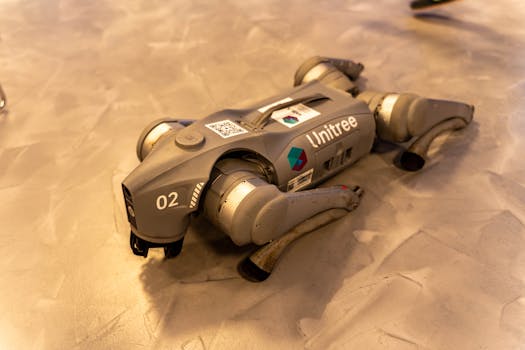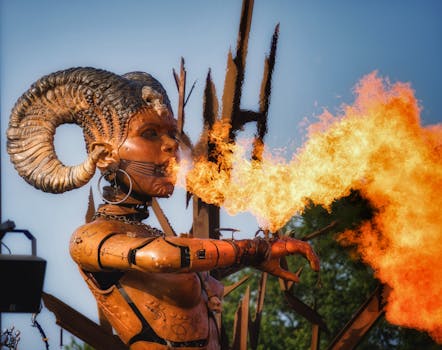Unleash Your Inner Artificer: Build a Mighty D&D 5e Automaton Fighter Stat Block
Introduction
Ever dreamt of commanding a loyal, unfeeling guardian on the battlefield? Perhaps you’ve faced down relentless warforged legions and wondered how to bring a similar mechanical marvel to your own D&D 5e campaigns. Building a formidable D&D 5e automaton fighter stat block can feel like a daunting task, akin to assembling a complex clockwork mechanism. But fear not, aspiring artificers and Dungeon Masters!
Many players and DMs struggle to find the perfect balance when creating custom creatures, especially those with the unique characteristics of automatons. You want something that feels distinct, powerful, and mechanically sound. In this guide, we’ll demystify the process, showing you exactly how to craft a compelling D&D 5e automaton fighter stat block that will stand the test of time (and adventurers!). We’ll cover everything from foundational mechanics to thematic abilities, ensuring your automaton is a true force to be reckoned with.
What Exactly is a D&D 5e Automaton?
In the realm of Dungeons & Dragons 5th Edition, an automaton is essentially a magically animated construct. Think of them as golems, but often more intricate, more specialized, and perhaps even possessing a rudimentary form of sentience or programmed purpose. They are not born, they are *made*. Crafted from metal, wood, stone, or even more exotic materials, automatons are imbued with magical energy that grants them life and allows them to follow their creator’s commands.
The appeal of an automaton is immense. They can serve as tireless guardians, dedicated soldiers, or even companions with unwavering loyalty. Unlike biological creatures, they don’t need to eat, sleep, or breathe, making them ideal for long-term assignments or hazardous environments. Understanding the core concept is crucial for building a truly effective D&D 5e automaton fighter stat block. They represent a fusion of artifice and arcane power, a testament to the ingenuity of their creators.
Here’s a breakdown of what makes an automaton tick in D&D 5e:
- Construct Nature: They are creatures of artificial origin, immune to many conditions that affect living beings, such as poison and disease. This is a fundamental aspect of any D&D 5e automaton fighter stat block.
- Magical Animation: Their existence is powered by magic, which dictates their capabilities and resilience.
- Purpose-Driven: Automatons are typically created with a specific function in mind, whether it’s combat, labor, or protection. This purpose heavily influences their abilities.
- Creator’s Will: Generally, they are controlled by their creator or a designated controller. This introduces interesting roleplaying and tactical possibilities.
Why is this relevant today? In a game that thrives on variety and customization, having a robust framework for creating unique creatures like automatons allows for deeper immersion and more dynamic encounters. Whether you need a personal bodyguard for your party’s wizard or a terrifying antagonist, a well-designed D&D 5e automaton fighter stat block is an invaluable tool.
Deep Dive: Crafting Your D&D 5e Automaton Fighter Stat Block
Creating a unique D&D 5e automaton fighter stat block involves more than just picking random abilities. It’s about understanding the creature’s role, its lore, and how its mechanical nature translates into game mechanics. Let’s get our gears turning!
First, consider the base chassis of your automaton. Is it a hulking brute designed for raw power, or a swift, agile combatant? This will influence its core stats.

1. Core Statistics (Ability Scores)
For a fighter automaton, Strength and Constitution are usually paramount. Dexterity can be important for accuracy and AC, while Intelligence and Wisdom might be lower unless your automaton has advanced programming.
- Strength (STR): High STR is key for a melee-focused automaton, impacting attack and damage rolls.
- Dexterity (DEX): Affects AC, ranged attacks, and initiative. A nimble automaton might have higher DEX.
- Constitution (CON): Determines hit points and fortitude saves. Constructs often have high CON due to their robust nature.
- Intelligence (INT): Relevant for tactical decision-making, especially if your automaton has advanced AI.
- Wisdom (WIS): Impacts perception and willpower saves.
- Charisma (CHA): Typically low for automatons unless they are designed for interaction or mimicry.
When building a D&D 5e automaton fighter stat block, prioritize Strength and Constitution to reflect its martial prowess and durability.
2. Armor Class (AC) and Hit Points (HP)
Automatons, being made of metal or other hard materials, usually have a decent base AC. Their HP should reflect their resilience.
- Armor Class: Start with a base AC appropriate for their materials (e.g., plate armor equivalent) and add any natural armor bonuses.
- Hit Points: Use a reasonable number of hit dice (d8, d10, or d12) based on their size and durability. Their CON modifier will significantly boost their HP pool.
Remember, a solid AC and substantial HP are hallmarks of a tough D&D 5e automaton fighter.

3. Speed and Movement
Standard speeds are fine, but consider specialized movement.
- Speed: Typically 30 ft.
- Special Movement: Perhaps a burrowing speed if it’s earth-based, or a limited flight if it has mechanical wings.
4. Senses and Resistances
Constructs often have unique senses and immunities.
- Darkvision: Essential for a creature that doesn’t rely on organic sight.
- Blindsight: Can represent advanced sensors.
- Immunities: Crucially, construct creatures are immune to poison damage and the poisoned condition, as well as disease. They also often have resistance or immunity to mind-affecting effects (charm, fear, paralysis).
- Vulnerabilities: Consider adding a vulnerability, like to lightning or thunder damage, to represent their mechanical nature.
This is where the “automaton” aspect truly shines in your D&D 5e automaton fighter stat block.
5. Actions and Abilities
This is where you inject personality and unique combat functions.
- Multiattack: A standard for fighters, allowing multiple attacks per turn.
- Weapon Attacks: Define their primary attacks – slam, sword, axe, integrated weaponry.
- Unique Abilities:
- Overclock: As a bonus action, increase its speed and attack rolls for a round, but take damage at the end of its next turn.
- Armored Defense: While not wearing armor, its natural armor provides a high AC.
- Construct Companion: If it’s a fighter supporting others, it might have abilities to buff allies or debuff enemies.
- Integrated Weaponry: Perhaps it has a built-in crossbow or a steam-powered fist.
- Repair Protocol: Can it self-repair, or does it require external maintenance?
- Saving Throws: High STR and CON saves are expected for a fighter.
Think about the automaton’s intended role. A guardian might have abilities focused on damage absorption and threat management, while an offensive automaton would focus on dealing high damage. Customizing these abilities is key to making your D&D 5e automaton fighter stat block feel unique.
Real-World Use Cases & Examples
Let’s bring this to life with some practical examples and expert insights. Imagine a campaign set in a world with advanced artificer guilds or ancient dwarven clockwork cities.

**Case Study: The Clockwork Vanguard**
Let’s build a CR 5 D&D 5e automaton fighter stat block.
* **Concept:** A heavily armored automaton built for frontline combat, designed to hold chokepoints.
* **Core Stats:** High STR, CON, moderate DEX.
* **AC:** 18 (natural armor).
* **HP:** 75 (10d10 + 20).
* **Speed:** 30 ft.
* **Senses:** Darkvision 60 ft., Passive Perception 10.
* **Immunities:** Poison, Exhaustion, Charmed, Frightened.
* **Resistances:** Bludgeoning, Piercing, and Slashing from nonmagical attacks.
* **Actions:**
* **Multiattack:** The automaton makes two Greatsword attacks.
* **Greatsword:** Melee Weapon Attack: +6 to hit, reach 5 ft., one target. Hit: 11 (2d6 + 4) slashing damage.
* **Siege Breaker (Recharge 5-6):** The automaton slams its massive fist into an object or creature. If targeting an object, it deals 22 (4d8 + 4) bludgeoning damage. If targeting a creature, it makes a single slam attack (+6 to hit) that deals 15 (2d8 + 4) bludgeoning damage plus 7 (2d6) thunder damage. On a hit, a creature of Large size or smaller must succeed on a DC 14 Strength saving throw or be pushed 10 feet and knocked prone.
This example demonstrates how to translate a concept into a functional D&D 5e automaton fighter stat block. For more inspiration on creating custom stat blocks, check out our guide on Designing Custom Monsters in D&D 5e.
You can also draw inspiration from existing lore. The Warforged race in Eberron offers fantastic thematic elements. For a deep dive into Eberron’s lore and how it can inspire your creations, this Eberron Campaign Setting guide is an excellent resource.
Key Considerations for Fighter Automatons:
* Action Economy: How many attacks can they make? Do they have bonus actions or reactions?
* Sustained Damage: Fighters are known for their consistent damage output.
* Defensive Capabilities: High AC and HP are standard, but what about damage resistances or temporary hit points?
* Engagement Range: Are they melee specialists, or do they have ranged options?
Remember to tailor these elements to the specific lore and challenge rating you aim for in your D&D 5e automaton fighter stat block.
Pros and Cons of Automaton Fighters
Like any creation, automaton fighters come with their own set of advantages and disadvantages. Understanding these can help you balance your D&D 5e automaton fighter stat block and present compelling challenges or allies to your players.
| Pros | Cons |
|---|---|
| ➕ Immune to many debilitating conditions (poison, disease, exhaustion, mind-altering effects). | ➖ Often lack creativity or independent thought unless specifically programmed. |
| ➕ Can be programmed for specific combat roles and tactics. | ➖ May have vulnerabilities to specific damage types (e.g., lightning, thunder) that exploit their mechanical nature. |
| ➕ Tireless; do not require rest, food, or water. | ➖ May be susceptible to EMP-like effects or specific magical attacks targeting constructs. |
| ➕ Can be built with integrated weaponry or specialized augmentations. | ➖ Repair and maintenance might be complex or require specialized knowledge/components. |
| ➕ Can provide unwavering loyalty and obedience. | ➖ Might be susceptible to control or hacking by enemy artificers. |
This balanced perspective is crucial when finalizing your D&D 5e automaton fighter stat block.
Conclusion
Building a mighty D&D 5e automaton fighter stat block is an art form, blending mechanical understanding with creative flair. We’ve journeyed through the core concepts, delved into the essential stats and abilities, and even explored practical applications. By focusing on their construct nature, programming their combat role, and considering their unique immunities and vulnerabilities, you can create automatons that are both mechanically sound and thematically rich.
Don’t be afraid to experiment! The beauty of D&D 5e lies in its flexibility. Use this guide as your blueprint, but feel free to innovate. Whether you’re a seasoned DM looking to add a new challenge or a player wanting to flesh out a unique ally, mastering the D&D 5e automaton fighter stat block is a rewarding endeavor. So, grab your tools, fire up your imagination, and start constructing your next mechanical marvel! Why not try designing a specific automaton for your next session and see how your players react? Happy crafting!